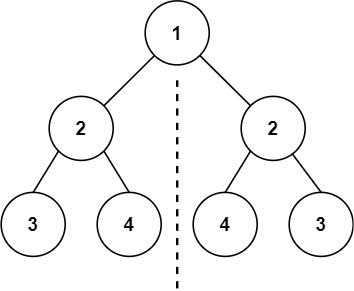Understand what the interviewer is asking for by using test cases and questions about the problem.
- Established a set (2-3) of test cases to verify their own solution later.
- Established a set (1-2) of edge cases to verify their solution handles complexities.
- Have fully understood the problem and have no clarifying questions.
- Have you verified any Time/Space Constraints for this problem?
HAPPY CASE
Input: root = [1,2,2,3,4,4,3]
Output: true
Input: root = [1,2,2,null,3,null,3]
Output: false
EDGE CASE
Input: root = []
Output: trueMatch what this problem looks like to known categories of problems, e.g. Linked List or Dynamic Programming, and strategies or patterns in those categories.
If you are dealing with Binary Trees some common techniques you can employ to help you solve the problem:
Plan the solution with appropriate visualizations and pseudocode.
General Idea: Recursively traverse both trees using Pre-Order traversal and check if each node is equal to the other.
1. Create isSameTree recursive function to traverse left and right child of root and check for symmetry.
a. Basecase: If both left and right child is None, then return True
b. If both left and right child are equal, then continue to check symmetry
c. Otherwise return False
2. If there is no root, then return True
3. Set left child as left tree and right child as right tree
4. Return isSameTree recursive function on the two trees. ⚠️ Common Mistakes
Implement the code to solve the algorithm.
# Definition for a binary tree node.
# class TreeNode:
# def __init__(self, val=0, left=None, right=None):
# self.val = val
# self.left = left
# self.right = right
class Solution:
def isSymmetric(self, root: Optional[TreeNode]) -> bool:
# Create isSameTree recursive function to traverse left and right child of root and check for symmetry
def isSameTree(p:Optional[TreeNode], q:Optional[TreeNode]) -> bool:
# Basecase: If both left and right child is None, then return True
if not p and not q:
return True
# If both left and right child are equal, then continue to check symmetry
if p and q and p.val == q.val:
return isSameTree(p.left, q.right) and isSameTree(p.right, q.left)
else:
# Otherwise return False
return False
# If there is no root, then return True
if not root:
return True
# Set left child as left tree and right child as right tree
p = root.left
q = root.right
# Return isSameTree recursive function on the two trees
return isSameTree(p,q)/**
* Definition for a binary tree node.
* public class TreeNode {
* int val;
* TreeNode left;
* TreeNode right;
* TreeNode() {}
* TreeNode(int val) { this.val = val; }
* TreeNode(int val, TreeNode left, TreeNode right) {
* this.val = val;
* this.left = left;
* this.right = right;
* }
* }
*/
class Solution {
public boolean isSymmetric(TreeNode root) {
// If there is no root, then return True and
// Return isSameTree recursive function on the two trees
return root==null || isSymmetricHelp(root.left, root.right);
}
// Create isSameTree recursive function to traverse left and right child of root and check for symmetry
private boolean isSymmetricHelp(TreeNode left, TreeNode right){
// Basecase: If both left and right child is None, then return True
if(left==null && right==null)
return true;
// If both left and right child are equal, then continue to check symmetry
if(left!=null && right!=null && left.val==right.val)
return isSymmetricHelp(left.left, right.right) && isSymmetricHelp(left.right, right.left);
// Otherwise return False
return false;
}
}Review the code by running specific example(s) and recording values (watchlist) of your code's variables along the way.
Evaluate the performance of your algorithm and state any strong/weak or future potential work.
Assume N represents the number of nodes in binary tree
O(N)
O(N) because unbalanced tree (space is used for the recursion stack). In the general case O(logN) for balanced tree.